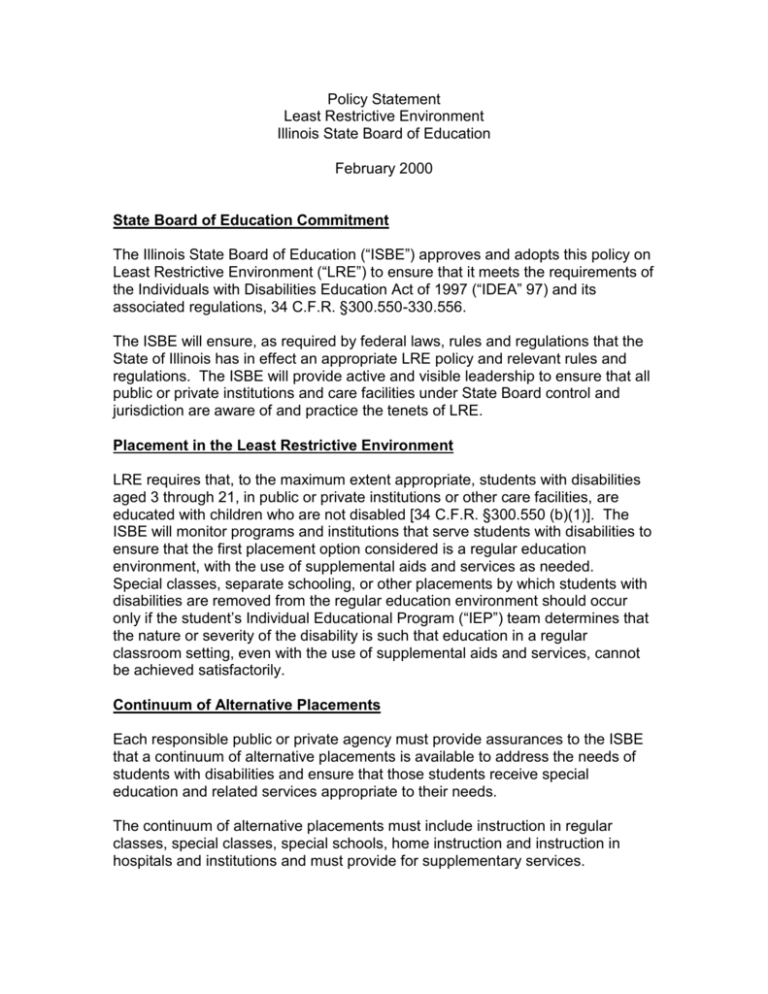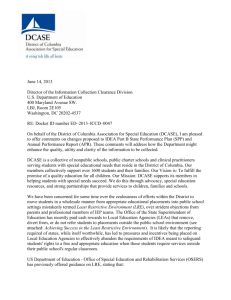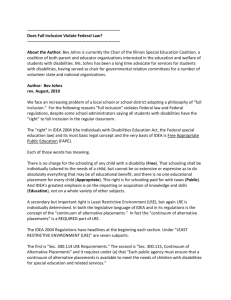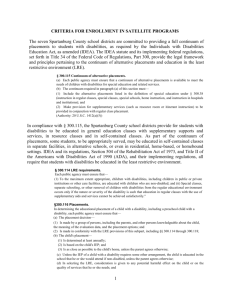Policy Statement Least Restrictive Environment
advertisement

Policy Statement Least Restrictive Environment Illinois State Board of Education February 2000 State Board of Education Commitment The Illinois State Board of Education (“ISBE”) approves and adopts this policy on Least Restrictive Environment (“LRE”) to ensure that it meets the requirements of the Individuals with Disabilities Education Act of 1997 (“IDEA” 97) and its associated regulations, 34 C.F.R. §300.550-330.556. The ISBE will ensure, as required by federal laws, rules and regulations that the State of Illinois has in effect an appropriate LRE policy and relevant rules and regulations. The ISBE will provide active and visible leadership to ensure that all public or private institutions and care facilities under State Board control and jurisdiction are aware of and practice the tenets of LRE. Placement in the Least Restrictive Environment LRE requires that, to the maximum extent appropriate, students with disabilities aged 3 through 21, in public or private institutions or other care facilities, are educated with children who are not disabled [34 C.F.R. §300.550 (b)(1)]. The ISBE will monitor programs and institutions that serve students with disabilities to ensure that the first placement option considered is a regular education environment, with the use of supplemental aids and services as needed. Special classes, separate schooling, or other placements by which students with disabilities are removed from the regular education environment should occur only if the student’s Individual Educational Program (“IEP”) team determines that the nature or severity of the disability is such that education in a regular classroom setting, even with the use of supplemental aids and services, cannot be achieved satisfactorily. Continuum of Alternative Placements Each responsible public or private agency must provide assurances to the ISBE that a continuum of alternative placements is available to address the needs of students with disabilities and ensure that those students receive special education and related services appropriate to their needs. The continuum of alternative placements must include instruction in regular classes, special classes, special schools, home instruction and instruction in hospitals and institutions and must provide for supplementary services. The IEP team must base its placement decision on the identified needs of each student with a disability. The team must first determine how or whether the individual needs of the student can be met in the regular education classroom with individual supports and aids. It must be able to justify a more restrictive option in terms of the LRE provisions and the needs of the student. Placements Each public or appropriate private agency that determines educational placements for students with disabilities must assure the ISBE that: Placements are based on the identified needs of individual students with disabilities as documented in their respective IEPs and considered only after the goals and objectives/benchmarks have been determined. Decisions about the placement of students with disabilities are made by a group of persons, including the parents and other persons knowledgeable about the child, who will review and evaluate relevant data and consider placement options appropriate to each student’s specific identified needs. Placement decisions conform to the LRE provisions referenced in state and federal laws, rules and associated regulations. Placements of students with disabilities are determined at least annually. Placements are located as close to the student’s home as possible. First consideration is given to the school the student would attend if not disabled and other placements are considered only if the IEP team determines that the student’s needs require a different location to ensure a free appropriate public education in the least restrictive environment. Full-time placement of a student with a disability in the general education setting is not appropriate where the student, despite the provisions of supplemental aids and services, is so disruptive in all or part of a general education setting that he/she significantly impairs the education of other students. Students with disabilities should not be removed from placement in an ageappropriate regular classroom solely because modifications or supports or services may be required in the general education curriculum or for administrative convenience. To the maximum extent appropriate, students with disabilities are involved in the regular education curriculum. The IEP must include a statement regarding the effect of the child’s disability on his or her progress and involvement in the general education curriculum. Each student’s IEP states whether the student will participate in state and/or local district assessments, and if so, whether fully or in part, and whether any modifications or accommodations are appropriate and necessary. If the student with a disability is excluded from these assessments, the IEP team describes what alternate assessment techniques will be used and how scores will be integrated and reported (34 C.F.R. §300.138-300.139). Nonacademic Settings The LRE mandate also applies to nonacademic services and extracurricular activities. School districts and other agencies serving students with disabilities must ensure that these students have an equal opportunity to participate in such activities (34 C.F.R. §300.553). When a district or appropriate private agency provides or arranges nonacademic and extracurricular services/activities appropriate for a student with disabilities, the IEP team must determine the required supplementary aids and services necessary for participation. Nonacademic and extracurricular services/activities may include, but not be limited to, meals, recess periods, counseling services, athletics, transportation, health services, recreational activities, special interest groups, referrals to agencies that provide assistance to individuals with disabilities, and employment of students, including both employment by the public agency and assistance in making outside employment available [34 C.F.R. §300.306(b)]. Children in Public or Private Institutions To ensure that students with disabilities are educated in the LRE and receive a free, appropriate public education, the ISBE will enter into agreements with appropriate public and private institutions and associated state agencies, as necessary. Technical Assistance and Training The ISBE will ensure that teachers and administrators in public agencies that deal with students with disabilities are fully informed about their responsibilities for implementing the LRE requirements. The ISBE will provide technical assistance and training necessary to assist in this effort. Monitoring Activities The ISBE will monitor public agencies to ensure that the LRE requirements are being implemented. If the ISBE discovers evidence that placements inconsistent with the LRE mandate are being made, staff will review the public agency’s justification and documentation and then help the agency plan and implement any necessary corrective action.







